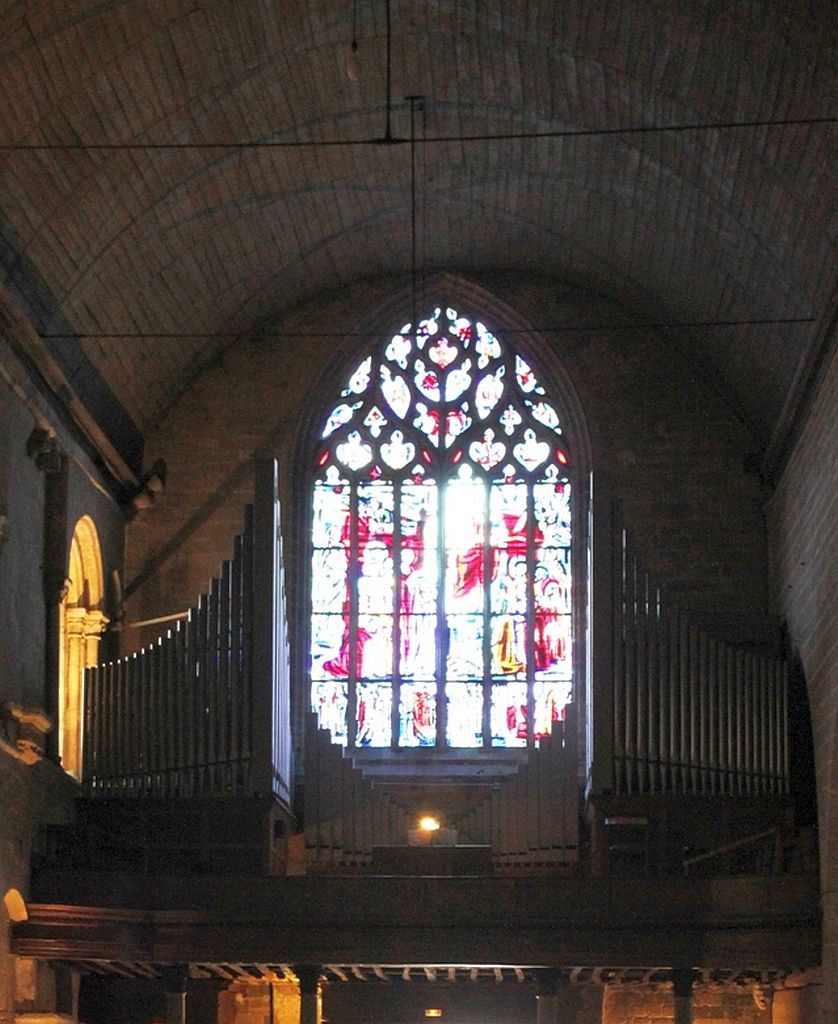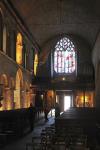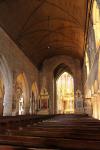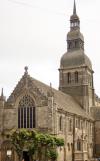Complete description of the selected organ

Photo: Aart Wimmenhove
Dinan, France (Côtes-d'Armor (22)) - Église Saint-Sauveur
Municipal: Dinan
Region:Bretagne
Address: 14 Place Saint-Sauveur, 22100, Dinan
Description nr.: 2024436.
Built by: Danion-Gonzalez (1966)
The organ contains older material: Pipes from 1837 by Aristide Cavaillé-Coll, from 1903 by Charles Mutin
In 1836-1837, Aristide Cavaillé-Coll built one of his first organs (opus 6) for the Église Saint-Sauveur in Dinan. The instrument had two manuals and a pedal with 24 stops in total. It wasa dedicated on February 3rd, 1839. In 1903 it was radically renovated and renewed by Charles Mutin. There were nine ranks left from the old organ after this work. In 1966 the organ was again radically renovated by the Danion-Gonzalèz company. They split the organ case into two parts, so that the window became visible. Since then, seven stops of Cavaillé-Coll are still existing in the instrument.
Technical data
Specification
Grand Orgue (C-g'''): Bourdon 16' - 1837, Montre 8', Violoncelle 8', Flûte 8', Bourdon 8' - 1837, Prestant 4', Nasard 2 2/3', Doublette 2' - 1837, Cornet 5 rangs - 1837, Fourniture 4 rangs, Trompette 8', Clairon 4'.
Positif (C-g'''): Principal 8', Cor de Nuit 8' - 1837, Salicet 4' - 1837, Doublette 2', Sesquialtera 2 rangs, Cromorne 8'.
Récit Expressif (C-g'''): Quintaton 16', Diapason 8', Flûte Traversière 8', Voix Céleste 8', Principal 4', Doublette 2', Plein Jeu 4 rangs, Basson 16', Trompette 8', Hautbois 8', Voix Humaine 8' - 1837, Clairon 4'.
Pédale (C-f'): Soubasse 16', Flûte 16', Bourdon 8', Flûte 4'.

Photo: Aart Wimmenhove
Dinan, France (Côtes-d'Armor (22)) - Église Saint-Sauveur
Municipal: Dinan
Region:Bretagne
Address: 14 Place Saint-Sauveur, 22100, Dinan
Description nr.: 2024436.
Built by: Danion-Gonzalez (1966)
The organ contains older material: Pipes from 1837 by Aristide Cavaillé-Coll, from 1903 by Charles Mutin
| Year | Builder | Opus | Activity | 1839 | Aristide Cavaillé-Coll | 6 | new organ | 1903 | Charles Mutin | rebuild | 1966 | Danion-Gonzalez | rebuild |
In 1836-1837, Aristide Cavaillé-Coll built one of his first organs (opus 6) for the Église Saint-Sauveur in Dinan. The instrument had two manuals and a pedal with 24 stops in total. It wasa dedicated on February 3rd, 1839. In 1903 it was radically renovated and renewed by Charles Mutin. There were nine ranks left from the old organ after this work. In 1966 the organ was again radically renovated by the Danion-Gonzalèz company. They split the organ case into two parts, so that the window became visible. Since then, seven stops of Cavaillé-Coll are still existing in the instrument.
Technical data
| Number of stops per division | |
| - Grand Orgue | 12 |
| - Positif | 6 |
| - Récit Expressif | 12 |
| - Pédale | 4 |
| Total number of stops | 34 |
| Key action | Electrical |
| Stop action | Electrical |
| Windchest(s) | Slider chests |
Specification
Grand Orgue (C-g'''): Bourdon 16' - 1837, Montre 8', Violoncelle 8', Flûte 8', Bourdon 8' - 1837, Prestant 4', Nasard 2 2/3', Doublette 2' - 1837, Cornet 5 rangs - 1837, Fourniture 4 rangs, Trompette 8', Clairon 4'.
Positif (C-g'''): Principal 8', Cor de Nuit 8' - 1837, Salicet 4' - 1837, Doublette 2', Sesquialtera 2 rangs, Cromorne 8'.
Récit Expressif (C-g'''): Quintaton 16', Diapason 8', Flûte Traversière 8', Voix Céleste 8', Principal 4', Doublette 2', Plein Jeu 4 rangs, Basson 16', Trompette 8', Hautbois 8', Voix Humaine 8' - 1837, Clairon 4'.
Pédale (C-f'): Soubasse 16', Flûte 16', Bourdon 8', Flûte 4'.
| Other specifications | |
|---|---|
| Different specifications |
The stoplist of Mutin (1903) was: Grand Orgue: Bourdon 16' (1837), Montre 8', Violoncelle 8', Flûte 8', Bourdon 8' (1837), Prestant 4', Nasard 2 2/3', Doublette 2' (1837), Cornet 5 rangs (1837), Trompette 8'. Positif: Principal 8', Salicional 8', Cor de Nuit 8' (1837), Salicet 4' (1837), Flûte Douce 4' (1837), Basson 8'. Récit Expressif: Quintaton 16', Diapason 8', Flûte Traversière 8', Viole de Gambe 8', Voix Céleste 8', Flûte Octaviante 4' (1837), Plein-Jeu 4 rangs, Basson 16', Trompette 8', Basson-Hautbois 8', Voix Humaine 8' (1837), Clairon Harmonique 4'. Pédale: Contrebasse 16' (1837), Soubasse 16', Flûte 8' (1837), Bombarde 16'. |
| Literature |
Les Orgues du Département des Côtes-du-Nord (Esquisse Historique) / H. Corbes. - Saint-Brieuc : Les Presses Bretonnes, 1966. - (Bulletins & Mémoires, Société d'Émulation des Côtes-du-Nord ; Tome XCIV). |
 |
 |
 |
